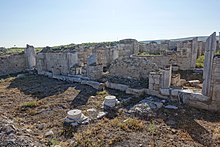Amorium
Ἀμόριον (in Greek) | |
 Ruins of Amorium | |
| Alternative name | Amorion, ʿAmmūriye, Amūrīn, Hergen Kale |
|---|---|
| Location | Hisarköy, Afyonkarahisar Province, Turkey |
| Region | Phrygia |
| Coordinates | 39°1′21″N 31°17′42″E / 39.02250°N 31.29500°E |
| History | |
| Periods | Hellenistic to High Middle Ages |
| Associated with | Aesop (legendarily), Michael II |
| Events | Sack of Amorium |
Amorium, also known as Amorion (
History
Antiquity
The city minted its own coins beginning between 133 BC to 27 BC until the 3rd century AD, indicating its maturity as a settlement and military importance during the pre-Byzantine period.[5] Amorium then must have been prestigious and prosperous. But early historical records that mention the city are strictly limited to a reference by Strabo, although it is expected that new discoveries will shed light on the city's Roman period and before.
Byzantine period

The city was fortified by the emperor
The town was rebuilt, but was burned by
It remained an important place in the 12th–14th centuries according to
Bishopric
Amorium was a
In the
No longer a residential bishopric, Amorium is today listed by the Catholic Church as a titular see.[13]
42 Martyrs
Following the 838 sack, 42 officers and notables of Amorium were taken as hostages to Samarra (today in Iraq). Refusing to convert to Islam, they were executed there in 845, and became canonized as the "42 Martyrs of Amorium".[14]
Excavations
Amorium's site was long unknown, though its name appears on many maps of the 18th and 19th centuries. It was rediscovered by Richard Pococke in 1739, but the first visit by a western scholar was by the English geologist William Hamilton in 1836; subsequently, maps placed it more accurately.[15]
In 1987, R.M. Harrison of Oxford University conducted a preliminary survey of the site, with excavations being started in 1988. From its inception the Amorium Excavations Project has been principally concerned with investigating post-classical, Byzantine Amorium.
After more than 20 years of British led excavation at Amorium, fieldwork restarted in 2014 with a new Turkish team under the direction of Doçent Doktor Zeliha Demirel Gökalp of Anadolu University, based at Eskisehir.[18] Amorium Excavations Project retains its character of international collaboration with foreign institutions, like the Institute of Mediterranean Studies of Foundation for Research & Technology – Hellas.[19]
Notable people
- Aesop (620-560 BC), Greek fable writer, legendarily from Amorion[20]
- Amorian dynasty
- Saint Blaise of Amorion(died 908), Christian monk and saint
References
- ^ a b c Herbermann, Charles, ed. (1907). . Catholic Encyclopedia. Vol. 1. New York: Robert Appleton Company.
- ^ a b c d M. Canard, "ʿAmmūriya" Archived 2020-07-27 at the Wayback Machine", Encyclopedia of Islam, Second Edition online 2012
- ^ Drew Bear, T.; DARMC; R. Talbert; S. Gillies; J. Åhlfeldt; T. Elliott (2018-06-07). "Places: 609302 (Amorion)". Pleiades. Archived from the original on 2020-11-01. Retrieved February 19, 2015.
- ^ Ivison, p. 27 Archived 2024-03-06 at the Wayback Machine
- ISBN 978-3-05-005828-3. Archivedfrom the original on 6 March 2024. Retrieved 4 July 2015.
- ISBN 978-975-8293-80-3. Archivedfrom the original on 6 March 2024. Retrieved 27 September 2016.
- ^ Timothy E. Gregory, A History of Byzantium, p. 228 Archived 2024-03-06 at the Wayback Machine
- ^ Speros Vryonis, The Decline of Medieval Hellenism in Asia Minor and the Process of Islamization from the Eleventh through the Fifteenth Century Archived 2017-02-02 at the Wayback Machine (University of California Press, 1971), pp. 21
- Bayerische Akademie der Wissenschaften, 1901, p. 539, nº 246.
- ^ Siméon Vailhé, v. Amorium, in Dictionnaire d'Histoire et de Géographie ecclésiastiques Archived 2020-10-07 at the Wayback Machine, vol. II, Paris 1914, coll. 1329–1331
- ^ Gaetano Moroni, Dizionario di erudizione storico-ecclesiastica, Vol. 2, p. 23
- ^ Michel Lequien, Oriens christianus in quatuor Patriarchatus digestus Archived 2024-03-06 at the Wayback Machine, Paris 1740, Vol. I, coll. 853-856
- ISBN 978-88-209-9070-1), p. 831
- Que sais-je ?, 1947
- ^ C.S. Lightfoot, "Coins at Amorium" in Constantina Katsari et al., The Amorium Mint and the Coin Finds, Amorium Reports 4, p. 5 Archived 2024-03-06 at the Wayback Machine
- ISBN 978-1-84171-538-4. Archivedfrom the original on 2024-03-06. Retrieved 2016-09-27.
- ^ "The Armorium Excavations Project". Amoriumexcavations.org. Archived from the original on 23 September 2008. Retrieved 2 August 2008.
- ^ "Bizans'ın Karanlık Dönemi Aydınlanıyor". Sondakika.com. 2013-11-04. Archived from the original on 2020-10-07. Retrieved 2015-09-16.
- ^ "Amorium Urban Archaeology". Amoriumurbarch.blogspot.gr. Archived from the original on 13 February 2016. Retrieved 24 June 2022.
- ^ Life of Aesop (10th century manuscript of 1st century text), cited in Tomas Hägg, The Art of Biography in Antiquity, p. 101
Sources
- Foss, Clive (1991). "Amorion". In ISBN 0-19-504652-8.
- Ivison, Eric A. (2007). "Amorium in the Byzantine Dark Ages (seventh to ninth centuries)". In Henning, Joachim (ed.). Post-Roman Towns, Trade and Settlement in Europe and Byzantium, Vol. 2: Byzantium, Pliska, and the Balkans. de Gruyter. pp. 25–59. ISBN 978-3-11-018358-0.
- Karolidis, Pavlos (1908). Η πόλις Αμόριον εν τη χριστιανική και μωαμεθανική ιστορία και ποιήσει [The city of Amorion in Christian and Mohammedan history and poetry] (in Greek). Athens: Τύποις Π. Δ. Σακελλαρίου.
- Lightfoot, Chris (2006). Amorium: A Byzantine City in Anatolia - An Archaeological Guide. Istanbul: Homer Kitabevi. ISBN 978-975-8293-80-3.

